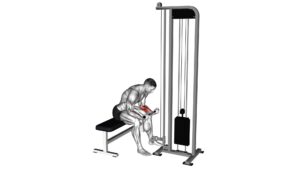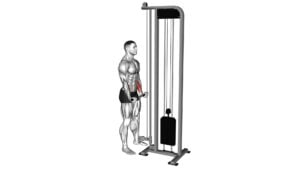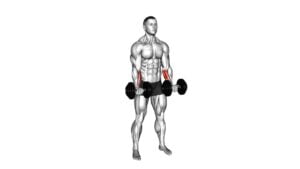Kettlebell Wrist Curl – Video Exercise Guide & Tips

If you're looking to strengthen your wrists and improve grip strength, the kettlebell wrist curl is a great exercise to add to your routine.
Watch This Exercise Video
In this video exercise guide, you'll learn the proper form and technique for performing this exercise.
We'll also cover variations and progressions, common mistakes to avoid, and provide tips for a successful kettlebell wrist curl.
Get ready to take your wrist strength to the next level!
Key Takeaways
- Kettlebell wrist curl strengthens wrists and improves grip strength
- Proper form and technique are essential for maximizing benefits and preventing injuries
- Gradually increasing intensity and progressions help avoid plateaus and promote continuous improvement
- Avoiding common mistakes such as incorrect wrist position and using too heavy of a weight is crucial for success.
Benefits of Kettlebell Wrist Curl
Improve your wrist strength and flexibility with the kettlebell wrist curl exercise. Wrist strength training is crucial for maintaining a strong grip and preventing injuries in various activities, such as weightlifting, racquet sports, and even everyday tasks.
By incorporating the kettlebell wrist curl into your workout routine, you can target the muscles in your wrists and forearms, enhancing their strength and stability.
The kettlebell wrist curl exercise primarily targets the flexor muscles in your wrists, which are responsible for bending your wrists downward. By strengthening these muscles, you can enhance your ability to perform actions that require a strong grip, such as holding onto heavy objects or performing exercises like deadlifts or pull-ups.
Additionally, the kettlebell wrist curl exercise can help prevent injuries, particularly in activities that involve repetitive wrist movements. Strengthening the wrist muscles can provide better support and stability to the joints, reducing the risk of sprains, strains, or other wrist-related injuries.
To perform the kettlebell wrist curl exercise, start by sitting on a bench or chair with a kettlebell in one hand, palm facing up. Slowly curl your wrist upwards, bringing the kettlebell towards your forearm, and then lower it back down. Repeat for the desired number of repetitions, and then switch to the other hand.
Incorporating the kettlebell wrist curl exercise into your routine can lead to improved wrist strength and flexibility, as well as reduced risk of wrist injuries. Remember to start with a weight that challenges you but still allows for proper form and gradually increase the resistance as your strength improves.
Proper Form and Technique
To perform the kettlebell wrist curl exercise with proper form and technique, follow these steps:
- Sit on a bench or chair with a kettlebell in one hand, palm facing up.
- Rest your forearm on your thigh or the bench, allowing your wrist to hang slightly off the edge.
- This position will help isolate the muscles of the wrist and forearm.
- Begin the exercise by curling your wrist upward, lifting the kettlebell as high as you can comfortably go.
- Pause briefly at the top of the movement.
- Slowly lower the kettlebell back down, allowing your wrist to extend fully.
- Repeat this motion for the desired number of repetitions.
- Switch to the other hand.
It is important to maintain proper form throughout the exercise. Keep your forearm stable and avoid any unnecessary movement. Your wrist should be the only joint that's actively moving. Remember to engage the muscles of your forearm to control the movement and avoid using momentum.
Performing wrist strengthening exercises like the kettlebell wrist curl can help improve wrist stability and mobility. Incorporating wrist mobility drills into your routine can further enhance the flexibility and range of motion in your wrists.
Now that you have mastered the proper form and technique for the kettlebell wrist curl, let's move on to exploring variations and progressions of this exercise.
Variations and Progressions
Now, let's explore some variations and progressions you can incorporate into your kettlebell wrist curl exercise.
To challenge yourself and take your wrist curls to the next level, you can try some advanced techniques. One option is to increase the weight of the kettlebell gradually as you build strength. Start with a lighter kettlebell and gradually work your way up to a heavier one. This will help to further strengthen your wrists and forearms.
Another advanced technique is to incorporate different equipment options. Instead of using a traditional kettlebell, you can try using a kettlebell with an offset handle. This will require more stability and grip strength, making the exercise more challenging.
Additionally, you can also try performing the wrist curl exercise on an unstable surface, such as a balance board or a stability ball. This will engage more muscles in your wrists and forearms as you work to stabilize the weight.
Remember to always prioritize proper form and technique when trying these advanced techniques. Start with lighter weights and gradually progress as you build strength and stability. Listen to your body and make sure to consult with a fitness professional if needed.
Common Mistakes to Avoid
To avoid common mistakes during the kettlebell wrist curl exercise, use proper form and technique. Here are three common mistakes to avoid when performing this exercise:
- Incorrect wrist position: One common mistake is allowing your wrists to bend too far back or forward during the exercise. This puts unnecessary strain on your wrists and can lead to injury. To avoid this, make sure to keep your wrists in a neutral position throughout the movement. This means keeping them straight and aligned with your forearms.
- Using too heavy of a weight: Another mistake is using a kettlebell that's too heavy for your current strength level. This can cause you to lose control of the weight and put excessive strain on your wrists. Start with a lighter weight and gradually increase as your strength improves.
- Relying on momentum: Many people make the mistake of using momentum to swing the kettlebell instead of relying on their wrist muscles to control the movement. This not only reduces the effectiveness of the exercise but also increases the risk of wrist injury. Focus on using slow, controlled movements and engage your wrist muscles throughout the entire range of motion.
Tips for a Successful Kettlebell Wrist Curl
Focus on maintaining a strong grip on the kettlebell throughout the entire movement for a successful kettlebell wrist curl. By improving your grip strength, you can maximize the benefits of this exercise and reduce the risk of wrist injuries.
Here are some tips to help you achieve success:
- Start with a suitable kettlebell weight: Choose a weight that challenges you without compromising your form. Gradually increase the weight as your grip strength improves.
- Proper hand position: Hold the kettlebell with a firm grip, making sure your fingers are wrapped around the handle. Avoid gripping too tightly, as this can strain your wrists.
- Engage your forearm muscles: As you curl your wrists, focus on squeezing your forearm muscles. This will help strengthen these muscles and enhance your grip strength.
- Maintain proper form: Keep your elbows close to your body and your wrists straight throughout the movement. Avoid bending your wrists or letting the kettlebell slip from your grip.
- Gradually increase the intensity: Once you have mastered the basic wrist curl, you can add variations such as using a thicker handle or performing the exercise on an unstable surface. These variations will further challenge your grip strength.
Frequently Asked Questions
How Heavy Should the Kettlebell Be for a Wrist Curl Exercise?
For a wrist curl exercise, you may wonder what weight kettlebell to use. The optimal weight for this exercise depends on your current strength and fitness level. It's important to start with a weight that challenges you but allows you to maintain proper form. Gradually increase the weight as your forearm strength improves.
Doing kettlebell wrist curls can benefit you by strengthening your forearms, improving grip strength, and enhancing overall upper body stability.
Can the Kettlebell Wrist Curl Exercise Help With Wrist Pain or Injury?
The kettlebell wrist curl exercise is effective for improving grip strength and can be beneficial for wrist pain or injury.
By incorporating kettlebell wrist curls into a wrist rehabilitation program, you can strengthen the muscles in your wrist and forearm, which may help alleviate pain and promote healing.
This exercise targets the specific muscles involved in wrist movement, providing a targeted and effective way to improve wrist function and reduce discomfort.
Is It Necessary to Warm up Before Performing the Kettlebell Wrist Curl Exercise?
Before performing the kettlebell wrist curl exercise, it's important to warm up your wrists. Warming up helps increase blood flow to the muscles and prepares them for the exercise.
Additionally, wrist mobility exercises can provide several benefits, such as improving flexibility and reducing the risk of injury. Wrist stability is crucial in strength training as it allows you to lift heavier weights and perform exercises with proper form.
How Often Should the Kettlebell Wrist Curl Exercise Be Performed for Optimal Results?
To achieve optimal results with the kettlebell wrist curl exercise, it's important to perform it regularly. By incorporating this exercise into your routine, you can strengthen your wrists and improve their flexibility.
The benefits of wrist strengthening exercises like the kettlebell wrist curl include enhanced grip strength and reduced risk of wrist injuries. Remember to maintain proper technique, keeping your elbows stationary and using controlled movements.
Are There Any Modifications or Alternatives for Individuals With Limited Wrist Mobility?
If you have limited wrist mobility, don't worry, there are modifications and alternatives you can try. These modifications can help you still work your wrists effectively while avoiding any discomfort or pain.
By adjusting the position of your hands or using different equipment, such as dumbbells or resistance bands, you can still target the muscles in your wrists and get a good workout.
Remember to consult with a professional or trainer for personalized advice.
Conclusion
In conclusion, the kettlebell wrist curl is an effective exercise for improving wrist strength and flexibility. It offers various benefits, including enhanced grip strength and forearm development.
By following proper form and technique, avoiding common mistakes, and incorporating variations and progressions, individuals can maximize the results of this exercise.
Remember to start with lighter weights and gradually increase the intensity as your wrist strength improves. With consistent practice and dedication, the kettlebell wrist curl can help you achieve your fitness goals.

Author
Years ago, the spark of my life’s passion ignited in my mind the moment I stepped into the local gym for the first time. The inaugural bead of perspiration, the initial endeavor, the very first surge of endorphins, and a sense of pride that washed over me post-workout marked the beginning of my deep-seated interest in strength sports, fitness, and sports nutrition. This very curiosity blossomed rapidly into a profound fascination, propelling me to earn a Master’s degree in Physical Education from the Academy of Physical Education in Krakow, followed by a Sports Manager diploma from the Jagiellonian University. My journey of growth led me to gain more specialized qualifications, such as being a certified personal trainer with a focus on sports dietetics, a lifeguard, and an instructor for wellness and corrective gymnastics. Theoretical knowledge paired seamlessly with practical experience, reinforcing my belief that the transformation of individuals under my guidance was also a reflection of my personal growth. This belief holds true even today. Each day, I strive to push the boundaries and explore new realms. These realms gently elevate me to greater heights. The unique combination of passion for my field and the continuous quest for growth fuels my drive to break new ground.







